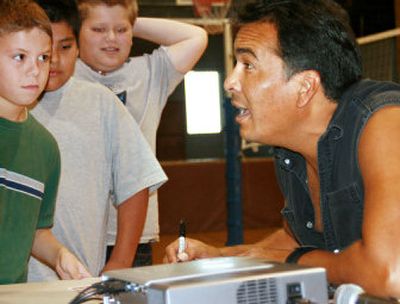Native American actor shares story line

GRAND COULEE, Wash. – If actor Eric Schweig gives the impression he’s more comfortable on the Colville Reservation than in Hollywood, it’s probably because the dress is more casual in the Northwest.
“Hollywood refuses to see us for what we are,” said Schweig, referring to Native Americans in general and Native American actors in particular. “They insist we run around in buckskins.”
Buckskins, typically tanned with buffalo brains, don’t smell so good after you’ve been on the set a while, Schweig told students at Grand Coulee Middle School on Thursday. The other actors tend to avoid you.
Schweig, 39, who is of Inuit and German heritage, got his big break in film when director Michael Mann cast him as Uncas alongside Daniel Day-Lewis as Hawkeye in 1992’s “Last of the Mohicans.”
More recently, he portrayed the villainous Chidin in Ron Howard’s “The Missing.”
He also is a well-known artist of Inuit masks.
This week, the actor has been relaxing on a Lake Roosevelt houseboat with his buddies, Chris Eyre, who directed “Skins” and “Smoke Signals,” and Ben Dupris, who teaches filmmaking to Indian youth for Big River Media on the Colville Reservation.
Schweig is on his way to Calgary to begin production of “Bury My Heart at Wounded Knee,” a mini-series directed by Yves Simoneau. Schweig will portray the Sioux leader Gall.
While in the area, Schweig has been visiting schools, including the Grand Coulee Middle School, where about half of the 200 students are Native American.
His talk began with a short biography.
Born in the Northwest Territories of Canada, he was raised from the age of 6 months by a German family near Inuvik. The 1960s and ‘70s was a time when many indigenous children were adopted out of their tribes, Schweig said with some resentment.
“I was abused by my keepers, and this led to alcoholism,” he said. “It took quite a lot to bounce back from that.”
He has been sober for eight years, Schweig told the middle-schoolers. Now directors are more willing to hire him, knowing he won’t wrap his car around a tree in the middle of film production.
Indian actors “are sort of at the bottom rung,” he said. “We don’t make a million dollars.” But he can get by on a couple of jobs a year.
His biggest paycheck was for “The Missing,” in which the tall, good-looking actor was transformed by latex prosthetics into a snake-handling sorcerer and kidnapper of little girls.
A snake wrangler from Texas stood in for the rattlesnake scenes. Otherwise, the actor said, he probably wouldn’t be here today. As it was, he was injured making “The Missing” when a helicopter spooked his horse.
“It was fun to play the bad guy,” Schweig said. “You get to kill and terrorize everybody and not go to jail.”
But while portraying Indians in big-budget Westerns may pay the bills, he said, it is not as satisfying as performing in independent films.
“The only way out of that whole system is to make our own films,” he told the students. “It is the only way we can change people’s perceptions.”
He is perhaps most proud of his performance in the Indy film “Big Eden,” in which he played Pike Dexter, a homosexual in a small Montana town.
In the 2000 film, Schweig kissed actor Ayre Gross five years before “Brokeback Mountain” shocked moviegoers.
“Gay people are going to see this, and they’ll know if we’re doing it wrong,” Schweig said he told his nervous co-star.
The performance earned Schweig, who is straight, the Grand Jury Prize for Outstanding Actor at Outfest, a gay and lesbian film festival.
“No one had ever seen Native American people in a scene like that before,” Schweig said.